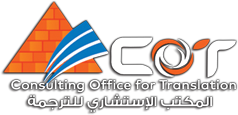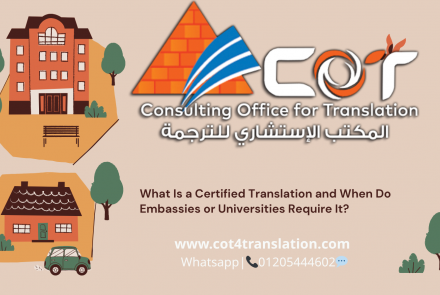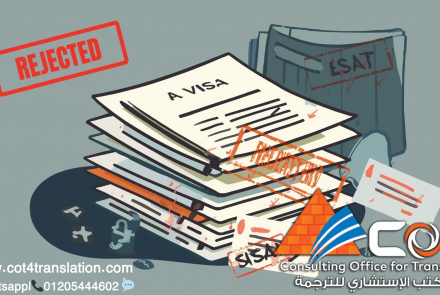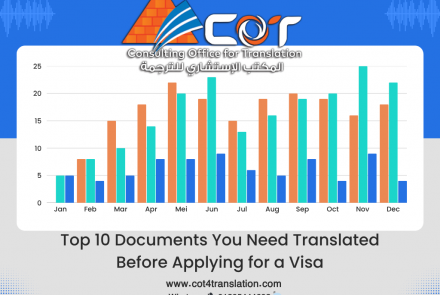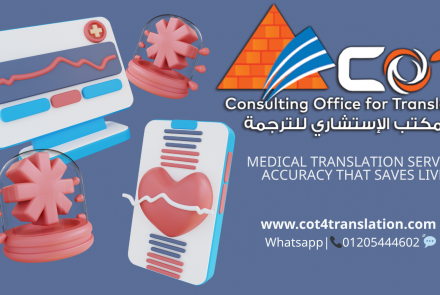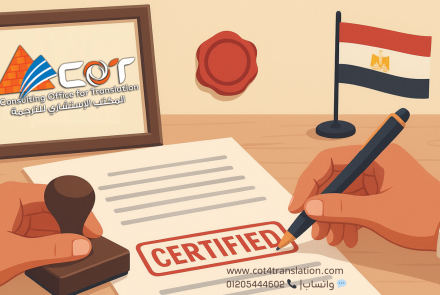Translation Mistakes That Can Delay Your Visa or University Application
Translation Mistakes That Can Delay Your Visa or University Application
When applying for a visa or university admission abroad, even the smallest translation mistake can cause major problems. A missing stamp, a wrong date, or a mistranslated phrase could delay — or even reject — your entire application. In Egypt, thousands of students and travelers face delays every year because their documents were translated incorrectly or not certified properly. At COT Translation, we’ve seen how these mistakes happen — and more importantly, how to avoid them. In this guide, we’ll explain the most common translation errors that can affect your visa or academic file, and how to ensure your documents are always accepted by embassies and universities worldwide.
1. Submitting Translations Without Certification
One of the most common mistakes applicants make is submitting non-certified translations. Embassies and universities do not accept translations that aren’t stamped and signed by a certified translation office.
- The official stamp and signature of the translation office
- A declaration confirming the translation’s accuracy
- The translator’s name and contact details
- The date and language pair (e.g., Arabic → English)
✅ Solution: Always use a certified translation office recognized by embassies — like COT Translation, approved by the German, Italian, Spanish, Canadian, and Australian embassies.
2. Inconsistent Names or Spelling
Many applicants lose valuable time because their names are spelled differently across documents. For example: Mohamed Ahmed Ali on a passport but Mohammed Ahmed Aly on a certificate. Even a single missing letter can lead to suspicion of document mismatch.
✅ Solution: Make sure all your documents use the exact same spelling as your passport. Provide a copy of your passport so the translator can double-check spellings.
3. Translating Without Understanding the Context
Some translators — especially inexperienced freelancers — translate literally without understanding the context or purpose of the document. This can lead to inaccurate legal or academic meanings, especially in employment letters, financial statements, academic transcripts, police or medical reports.
✅ Solution: Work with translators who specialize in your document type. At COT Translation, each translator works within their expertise — legal, medical, academic, or financial.
4. Missing Embassy or University Requirements
Every embassy and university has specific formatting or language requirements. Examples:
- The German Embassy requires translations into German only.
- The Italian Embassy requires Italian-language translations certified by an authorized office.
- Many universities require English translations in PDF format with an official stamp on each page.
✅ Solution: Check the requirements of your destination embassy or university beforehand — or consult COT Translation and we'll guide you through every step.
5. Omitting Dates, Signatures, or Stamps
Official documents are not valid without dates, signatures, or seals — and the same applies to their translations. Some translators forget to include the official format of the document (issue date, place, or authority).
✅ Solution: Always check your translation before submission. We cross-verify each page to ensure the translated document mirrors the original in layout and content — including signatures, headers, and reference numbers.
6. Using Machine Translation or Online Tools
Online translation tools (like Google Translate) can be helpful for quick understanding — but they are not suitable for official use. Embassies and universities immediately reject machine-translated documents.
✅ Solution: Use certified human translators who understand both the language and legal context. COT Translation employs professional linguists with years of experience.
7. Failing to Translate All Attached Pages
Sometimes applicants only translate the main page of a document and ignore attachments like annexes, tables, or back-side notes. Embassies consider this an incomplete translation, and they may return the file.
✅ Solution: Translate the entire document, including every page, appendix, and stamp. Our translators review all details to ensure nothing is left untranslated.
8. Not Reviewing the Final Translation
Even if your translation is certified, errors can still happen — especially with names, numbers, or dates. Applicants often submit translations without proofreading them first.
✅ Solution: Review the translation side-by-side with the original document. COT Translation offers a double-review process where both translator and editor verify all details before stamping.
9. Choosing Unrecognized or Unverified Translation Offices
Not every office claiming to be “certified” is officially recognized by embassies. Unverified offices may issue translations that embassies refuse to accept — wasting your time and money.
✅ Solution: Choose a reputable and embassy-approved office with verifiable experience. COT Translation has been trusted since 1992, with translations accepted by all major embassies and consulates in Egypt.
10. Not Keeping Digital Copies of Translations
Many applicants misplace their printed translations or need copies for other applications. If you don’t have a digital version, you’ll need to retranslate everything from scratch.
✅ Solution: Ask for a PDF copy of your certified translation. COT Translation provides both printed and digital formats, ready for online submissions and embassy uploads.
Why Work with COT Translation?
- Over 30 years of certified experience
- Translations accepted by all embassies and universities in Egypt
- Expertise in legal, academic, and medical translation
- Delivery within 24–48 hours
- Full confidentiality guaranteed
- Available in 40+ languages
Our Branches
Contact us directly
FAQ – Avoiding Translation Mistakes
It must have the official stamp, signature, and declaration from a certified translation office.
Provide a passport copy to your translator — they will match the spelling across all translations.
Usually 24–48 hours, depending on the number of pages.
Yes, simply send your scans via WhatsApp or email. You’ll receive your certified translation digitally or printed.
Our translations are accepted by German, Italian, Spanish, Canadian, Australian, and Portuguese embassies in Egypt.
Conclusion
When it comes to visa and university applications, accuracy matters. One small translation error can delay your dreams — or stop them altogether. By working with a certified and experienced provider like COT Translation, you can ensure every document is accepted the first time.
